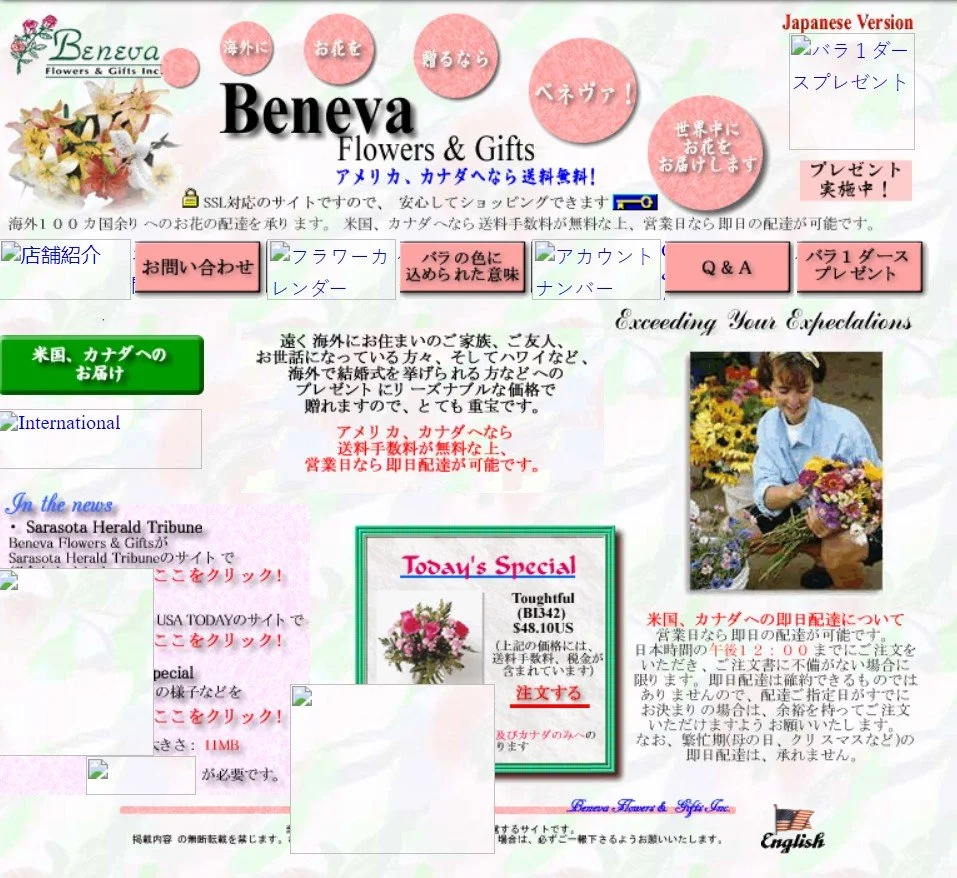Flower Manager: How it Started
Art Conforti and the Team at Gravity Free: An Unstoppable Force
Beneva Flowers & Gifts was an early innovator in floral technology. They even featured a Chinese version of their website that ran overseas.
The late 1990s were a time of experimentation and uncertainty for florists stepping into the online world. “Most shops thought a website was enough,” Art recalled. “But without strategy, marketing, and systems, it was really just a digital brochure.”
In 1996, Art first went online with Sarasota Online, hosting his Beneva.com website, one of the earliest ways small businesses could dip their toes into the web. “Back then, even having a basic website felt forward-thinking,” he said. For many florists, simply listing their name and phone number online felt like innovation.
But those early attempts didn’t go smoothly. After two failed tries—and after the company was eventually bought out by Comcast—the service began to slip, leaving Art frustrated. That’s when he met Vince at Coastal Web, who helped take his vision to the next level.
Vince turned out to be different. He didn’t just build a simple site - he pushed boundaries and experimented with ideas far ahead of their time. “He even built a Chinese version of our website that ran overseas,” Art recalled. “For a local flower shop, that was unheard of.” It showed the hidden potential of technology if used strategically. Still, as forward-thinking as Vince was, there came a point when Art realized he had outgrown Coastal Web, and his vision for florists online would require an even bigger leap.
The Birth of Flower Manager and the Florist App
Meeting with Scott Heaps and Tina at Gravity Free.
That leap came through a partnership with developer Scott Heaps and Ray Villares at Gravity Free. Together, they transformed Art’s vision into what became Flower Manager, a platform that redefined how florists managed online sales.
“Scott was the developer, I was the retailer,” Art explained. “I gave him the vision for what florists truly needed, and Scott and his team built the technology to make it possible.”
Around this same time, Art also collaborated with Raj Dorsami of Tracer Pro to create a dedicated flower app, extending his vision into the mobile space and giving florists another powerful tool to connect with customers.
Not every idea translated easily between the world of developers and florists. “At one point, Scott wanted every flower to be identified and counted,” Art recalled. “I told him absolutely not. That’s the experience of a true florist talking—we don’t itemize every stem. We look at the overall picture and buy it.” That mix of practical florist knowledge and technical innovation became the secret to Flower Manager’s success.
Flower shop sales were down - including Art’s.
But he did something about it.
Local news media featured Art’s new floral app, 2012
Art didn’t keep his ideas to himself. He went on the road, visiting 50 flower shops across the country and listening carefully to their challenges. “I brought all that feedback back to Scott and the team,” he said. “Every florist had similar struggles, and we built the tools they actually needed to solve them.”
The first big test came on Valentine’s Day, when a surge of orders overwhelmed the servers. “That was the moment we realized the opportunity was much bigger than we imagined,” Art said. “We needed more servers, more florists, and stronger support.”
Florists also wanted more than just a website—they wanted long-term support. To meet that need, Art launched Advanced Marketing Solutions, focusing on marketing and management while Gravity Free handled the technical side. This gave shops something the industry had been missing: a partner who would stay engaged after the website went live.
With so much money going into advertising, Art also pushed for tools that could track results. That led to systems connecting phone calls, web clicks, and POS sales—proof that online marketing worked. One standout was Flower Prodigy, a call-tracking innovation that was later purchased by Teleflora.
As the platform matured, the collaboration between retailers and developers only grew stronger. Every new feature was tested in real flower shops, refined based on feedback, and then scaled across the network. That cycle of listening, adapting, and improving created not just software, but a living system that evolved with the needs of florists—laying the foundation for a lasting legacy.
A Legacy of Collaboration
“For the first time, florists could actually see how online and phone sales connected,” Art said. By the time he retired in 2016, after 30 years in the business, Sarasota had become a hub where florists gathered to share ideas and plan for the future.
Scott and his team at Gravity Free have since carried Flower Manager forward, but Art remains proud of the original spark. “It wasn’t just my idea, and it wasn’t just Scott’s technology—it was the collaboration that made it work,” Art reflected.
Even today, Art continues to share those lessons with florists and business owners: that technology is only as powerful as the strategy behind it, and that the best solutions come when innovators, developers, and retailers work side by side. The success of Flower Manager proves that lasting progress in any industry is built on partnership, not competition.
Art with Michael and Tim Pugh of Pugh’s Flowers, Memphis, TN.
With Mary Murray’s Flowers, Houston, TX.
Jim and Sheila of Rose Bud Flowers, Mobile, AL.
Breen’s Florist of Houston, TX.
The Lesson for Florists
The lesson is simple: collaboration leads to success.
Shared ideas lowered costs and raised standards
Ongoing support turned websites into profitability tools
Innovation was not optional—it was survival
If you want your flower shop to thrive, don’t just look for the cheapest option. Invest in systems built on real florist experience and proven technology - the same blend that fueled Flower Manager’s success.
Flower Manager was never the product of one person or one company alone—it was the result of florists, developers, and marketers working together toward a common goal. If you want your flower shop to thrive, don’t just look for the cheapest option. Invest in systems built on real florist experience, proven technology, and partnerships that grow with you. That blend of collaboration and innovation is what transformed the industry, and it’s still the formula for success today.
Q&A Spotlight
Q: Did Art really visit every florist that got a website?
A: Yes. Because this was such a new and innovative product, Art personally flew to over 100 shops across the country. He wanted to understand each florist’s unique challenges — from their books and recordkeeping to their delivery vans and final presentation. Most importantly, he met directly with the shop owners, because employees change but ownership drives long-term success.
Q: What was Art looking for when he visited a flower shop?
A: More than just pretty floral designs. Art evaluated how shops managed operations, from accounting systems to order tracking, and how much detail went into the finished bouquet delivered to a customer’s door. His goal was to see the full picture — where technology could make the greatest impact.
Want to hear more straight from Art?
Art has answered some of the most common questions about his work with florists, Flower Manager, and the future of the floral industry.







